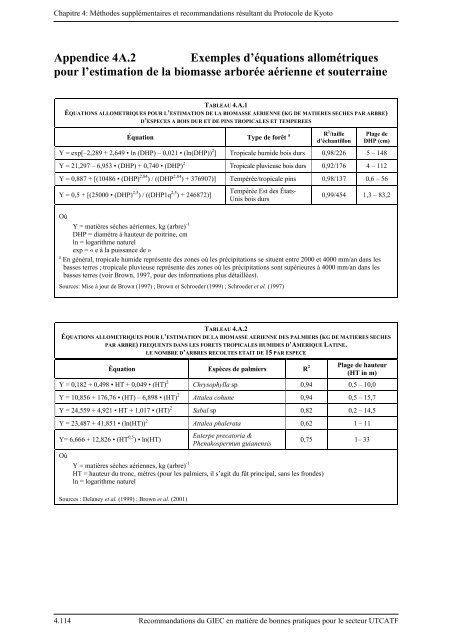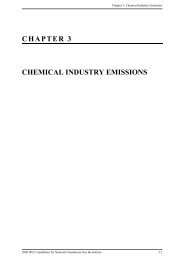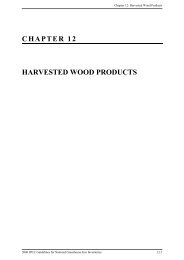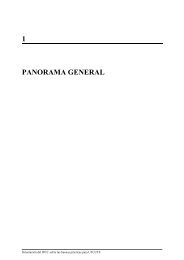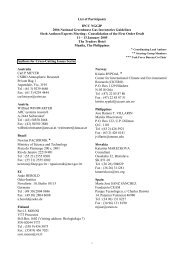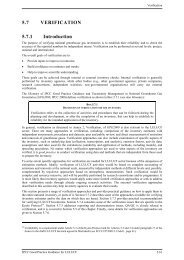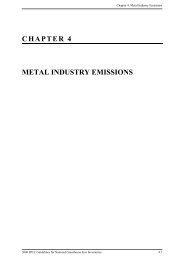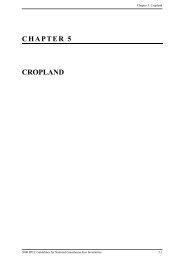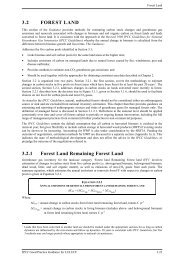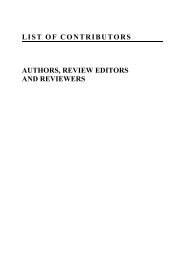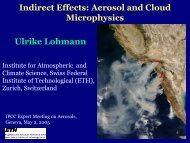méthodes supplémentaires et les recommandations en matière
méthodes supplémentaires et les recommandations en matière
méthodes supplémentaires et les recommandations en matière
You also want an ePaper? Increase the reach of your titles
YUMPU automatically turns print PDFs into web optimized ePapers that Google loves.
Chapitre 4: Méthodes supplém<strong>en</strong>taires <strong>et</strong> <strong>recommandations</strong> résultant du Protocole de Kyoto<br />
App<strong>en</strong>dice 4A.2 Exemp<strong>les</strong> d’équations allométriques<br />
pour l’estimation de la biomasse arborée aéri<strong>en</strong>ne <strong>et</strong> souterraine<br />
TABLEAU 4.A.1<br />
ÉQUATIONS ALLOMETRIQUES POUR L’ESTIMATION DE LA BIOMASSE AERIENNE (KG DE MATIERES SECHES PAR ARBRE)<br />
D’ESPECES A BOIS DUR ET DE PINS TROPICALES ET TEMPEREES<br />
Équation Type de forêt a R2 /taille<br />
d’échantillon<br />
Plage de<br />
DHP (cm)<br />
Y = exp[–2,289 + 2,649 • ln (DHP) – 0,021 • (ln(DHP)) 2 ] Tropicale humide bois durs 0,98/226 5 – 148<br />
Y = 21,297 – 6,953 • (DHP) + 0,740 • (DHP) 2 Tropicale pluvieuse bois durs 0,92/176 4 – 112<br />
Y = 0,887 + [(10486 • (DHP) 2,84 ) / ((DHP 2,84 ) + 376907)] Tempérée/tropicale pins 0,98/137 0,6 – 56<br />
Y = 0,5 + [(25000 • (DHP) 2,5 ) / ((DHP1q 2,5 ) + 246872)]<br />
Tempérée Est des États-<br />
Unis bois durs<br />
0,99/454 1,3 – 83,2<br />
Où<br />
Y = matières sèches aéri<strong>en</strong>nes, kg (arbre) -1<br />
DHP = diamètre à hauteur de poitrine, cm<br />
ln = logarithme naturel<br />
exp = « e à la puissance de »<br />
a En général, tropicale humide représ<strong>en</strong>te des zones où <strong>les</strong> précipitations se situ<strong>en</strong>t <strong>en</strong>tre 2000 <strong>et</strong> 4000 mm/an dans <strong>les</strong><br />
basses terres ; tropicale pluvieuse représ<strong>en</strong>te des zones où <strong>les</strong> précipitations sont supérieures à 4000 mm/an dans <strong>les</strong><br />
basses terres (voir Brown, 1997, pour des informations plus détaillées).<br />
Sources: Mise à jour de Brown (1997) ; Brown <strong>et</strong> Schroeder (1999) ; Schroeder <strong>et</strong> al. (1997)<br />
TABLEAU 4.A.2<br />
ÉQUATIONS ALLOMETRIQUES POUR L’ESTIMATION DE LA BIOMASSE AERIENNE DES PALMIERS (KG DE MATIERES SECHES<br />
PAR ARBRE) FREQUENTS DANS LES FORETS TROPICALES HUMIDES D’AMERIQUE LATINE.<br />
LE NOMBRE D’ARBRES RECOLTES ETAIT DE 15 PAR ESPECE<br />
Équation Espèces de palmiers R 2 Plage de hauteur<br />
(HT in m)<br />
Y = 0,182 + 0,498 • HT + 0,049 • (HT) 2 Chrysophylla sp 0,94 0,5 – 10,0<br />
Y = 10,856 + 176,76 • (HT) – 6,898 • (HT) 2 Attalea cohune 0,94 0,5 – 15,7<br />
Y = 24,559 + 4,921 • HT + 1,017 • (HT) 2 Sabal sp 0,82 0,2 – 14,5<br />
Y = 23,487 + 41,851 • (ln(HT)) 2 Attalea phalerata 0,62 1 – 11<br />
Y= 6,666 + 12,826 • (HT 0,5 Euterpe precatoria &<br />
) • ln(HT)<br />
0,75 1– 33<br />
Ph<strong>en</strong>akospermun guian<strong>en</strong>sis<br />
Où<br />
Y = matières sèches aéri<strong>en</strong>nes, kg (arbre) -1<br />
HT = hauteur du tronc, mètres (pour <strong>les</strong> palmiers, il s’agit du fût principal, sans <strong>les</strong> frondes)<br />
ln = logarithme naturel<br />
Sources : Delaney <strong>et</strong> al. (1999) ; Brown <strong>et</strong> al. (2001)<br />
4.114 Recommandations du GIEC <strong>en</strong> matière de bonnes pratiques pour le secteur UTCATF


